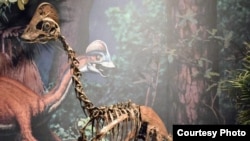Paleontologists have identified the remains of a previously unknown, bird-like species of dinosaur that roamed North America nearly 70 million years ago. The giant feathered creature belongs to a group of plant- and meat-eaters found in Central and East Asia.
It looked like a cross between an enormous chicken and a giant lizard, producing what one paleontologist described as a “stretched out chicken.” The dinosaur, now called Anzu wyliei, had a beak but no teeth, a long neck, a bony crest on the top of its head and razor-sharp claws.
"So you basically had this great big, bird-like creature with a long tail, long arms ending in huge claws, feathers over all of its body," said Hans-Dieter Sues, curator of vertebrate paleontology at the Smithsonian Institution’s National Museum of Natural History.
"Even though we have not gotten the actual feather fossils from Anzu, we have closely related animals from China which are actually preserved with beautiful feather impressions," he said.
The new species was identified from three sets of fossils unearthed from the Upper Cretaceous Hell Creek Formation in North and South Dakota, giving it the nickname, The Chicken from Hell. It stood more than three-and-a-half meters tall and weighed between 200 and 300 kilograms.
An almost complete skeleton resides at the Carnegie Museum of Natural History in Pittsburgh, Pennsylvania. Smithsonian paleontologists discovered one of the fossils and helped describe the findings, which are reported in the journal PLOS One.
Sues says the giant, feathered species belongs to a family of omnivorous dinosaurs called Oviraptorosauria.
He says Anzu, named for a mythological winged creature from Mesopotamia, ate both plants and animals, preferring to live in swampy areas.
One of the very last dinosaurs to inhabit the United States, Sues says Anzu existed alongside the horned triceratops and ferocious Tyrannosaurus rex. But with its long, powerful legs and clawed wing-tips, this dinosaur was not easy prey.
"Anyone who has tried to corner an ostrich today has lived to regret this because these animals, when they are cornered, they will certainly defend themselves very effectively; particularly this animal with its huge hand claws would certainly [have] shredded an attacker," he said.
The dinosaur family to which A. wyliei and its Asian cousins belong was extremely diverse, including species as small as turkeys and as large as Anzu.
For almost a hundred years, scientists have suspected the existence of giant oviraptosaurs in North America. The latest fossil evidence confirms that. Sues says there may be bones in other collections that will help paleontologists paint a more detailed picture of Anzu.
It looked like a cross between an enormous chicken and a giant lizard, producing what one paleontologist described as a “stretched out chicken.” The dinosaur, now called Anzu wyliei, had a beak but no teeth, a long neck, a bony crest on the top of its head and razor-sharp claws.
"So you basically had this great big, bird-like creature with a long tail, long arms ending in huge claws, feathers over all of its body," said Hans-Dieter Sues, curator of vertebrate paleontology at the Smithsonian Institution’s National Museum of Natural History.
"Even though we have not gotten the actual feather fossils from Anzu, we have closely related animals from China which are actually preserved with beautiful feather impressions," he said.
The new species was identified from three sets of fossils unearthed from the Upper Cretaceous Hell Creek Formation in North and South Dakota, giving it the nickname, The Chicken from Hell. It stood more than three-and-a-half meters tall and weighed between 200 and 300 kilograms.
An almost complete skeleton resides at the Carnegie Museum of Natural History in Pittsburgh, Pennsylvania. Smithsonian paleontologists discovered one of the fossils and helped describe the findings, which are reported in the journal PLOS One.
Sues says the giant, feathered species belongs to a family of omnivorous dinosaurs called Oviraptorosauria.
He says Anzu, named for a mythological winged creature from Mesopotamia, ate both plants and animals, preferring to live in swampy areas.
One of the very last dinosaurs to inhabit the United States, Sues says Anzu existed alongside the horned triceratops and ferocious Tyrannosaurus rex. But with its long, powerful legs and clawed wing-tips, this dinosaur was not easy prey.
"Anyone who has tried to corner an ostrich today has lived to regret this because these animals, when they are cornered, they will certainly defend themselves very effectively; particularly this animal with its huge hand claws would certainly [have] shredded an attacker," he said.
The dinosaur family to which A. wyliei and its Asian cousins belong was extremely diverse, including species as small as turkeys and as large as Anzu.
For almost a hundred years, scientists have suspected the existence of giant oviraptosaurs in North America. The latest fossil evidence confirms that. Sues says there may be bones in other collections that will help paleontologists paint a more detailed picture of Anzu.







